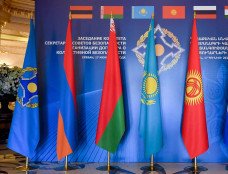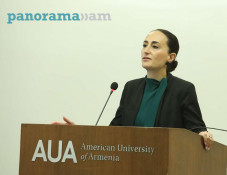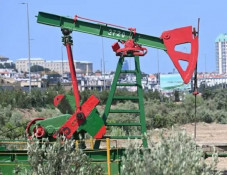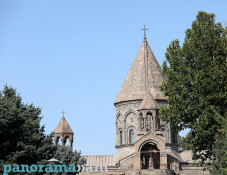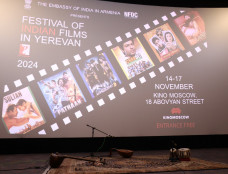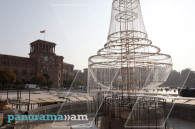
Rouben Galichian: Medieval maps rule out Azerbaijan’s existence allegedly to north of Araks
Muhammad bin Abdullah bin Idris al-Sharif al-Idrisi, a famous Arab geographer of 11-12th centuries, was born in Ceuta, Morocco. He travelled in many countries and studied in Cordoba, an important cultural centre of those times, where he studied Catalan and Portuguese marine maps, portolans. In his book Historical and Geographical Falsifications of Azerbaijan, a historical, cultural and cartographical research based on a detailed analysis backed by documentary evidence, famous cartographer Rouben Galichian analyses the maps compiled by al-Idrisi and others.
Al-Idrisi travelled across Europe, Middle and Central Asia, gathering a vast amount of geographic information. A manuscript created by him in 1154 contains a world map compiled in accordance with the principles of the school of Balkhi, where the habitable part of the world is divided into seven climatic zones, which are further broken into ten parts. The book includes 70 detailed maps, each map with relevant descriptive text.
Galichian presents one of al-Idrisi’s maps showing the area to the south of Caucasus, situated in the fifth climate zone. Here, Near East, Caucasus and Asia Minor appear with the map drawn with south at the top as per the tradition of Islamic maps.
“From the towns of Armenia, Bitlis, Kalikla (Karin-Erzrum), Khlat, Arjesh, Dvin, Nakhijevan (here Nashui), Arzan and Salmast are shown. The blue lake at the top left is the Caspian and the green circle above is Lake Van. Even in this map of 1154, Bilad al-Waq (Aghvank – Arran) is north of the river Araks, while Atrpatakan-Adrbedzhan are on the southern bank of the river. The cities of Aghvank mentioned here include Bab al-Abwab, Shamakhi, Shamkhor, Varzaqan, Tiflis and others,” Galichian writes and adds that the Persian Azerbaijan-Atrpatakan is placed south of Araks, Ardabil and Barzand being among its cities.
According to this map, there are three countries in the region: Azerbaijan, located south of Araks; Aghvank, north of Araks; and Armenia on both sides of Araks and extending further to the south. No country named ‘Azerbaijan’ is mentioned on the map, Galichian writes.
Philip de la Rue’s Map of Armenia (1653) shows four lands: Greater Armenia, Second, Third and Fourth Armenia. Galichian points out that these were the administrative divisions during the rule of Emperor Justinian I the Great (483-565).
Although the map is titled Armenia, it includes the neighbouring countries as well. To the north-east of Armenia is Aghvank-Albania and to its east is Media-Atrpatakan. “The map once again proves the existence of those countries in the region and the absence of ‘Southern’ and ‘Northern’ Azerbaijan,” Galichian highlights.
The map compiled by Nicolas Sanson (1600-1667) in 1648 shows the Historical Armenia, Colchis, Georgia and Aghvank. “According to this French cartographer, the countries located to the north of the Caucasus are Armenia, Media, Georgia-Iberia, Colchis and Aghvank-Albania. That is, different peoples inhabited these countries,” Galichian writes and notes the absence of any mention about ‘Northern’ and ‘Southern’ Azerbaijan on this map. There is none of these names and notions as there were no such countries existing in that historical period.
Johannes Blaeu (1596-1673) from a famous Dutch cartographic family was celebrated with his Atlas Maior. This 12-volume atlas contains 600 large maps of all the regions of the world and more than 3,000 pages descriptions. It is considered one of the masterpieces of world cartography. The atlas was published many times over and in different languages in the 17th century.
The map of ‘The Turkish Empire,’ or rather its eastern outskirts with Armenia and neighbouring lands, published in Galichan’s book, is taken from an atlas of 1664-1665. Here, Armenia is shown within the borders of Turkey (the borders of the empire are drawn in yellow); Shirvan is in the east on the right, it is the ancient Aghvank and Media-Atrpatakan, which were a part of Persia at that time, Galichain writes.
The map of ‘Asiatic Turkey’ prepared by Pierre Duval (1619-1683), Sanson’s son-in-law and his Geographer Royal, is based on the information provided by the well-known Arab historian and geographer Abul-Fida Ismail (1273-1332). It shows Persia, Arabia and Africa.
According to this map, most of Armenia is under Turkish rule. Among its towns, mentioned on the map, are Yerevan, Kars, Van and Nakhijevan. Adherbeizan appears within Persia and its name embraces the settlements of Chui (Khoy), Ardebil, Senkan (Zanjan), Maragha and Sultaniye, all being cities of the Iranian province of Atrpatakan. The territory north of Araks (referred to as Arais) is named Shirvan, with Shamakhi being mentioned as one of its cities.
“Another map, showing the factual location of the real, historical Azerbaijan,” Galichian writes.
Johann David Kohler’s (1684-1755) School and Travel Atlas was drawn by cartographer Christoph Weigel (1654-1725) in Nuremberg, Germany in 1718. Galichian refers to one of the maps from this atlas in his Historical and Geographical Falsifications of Azerbaijan.
The map of Armenia is published in the section ‘Antique World’ under number 27. It shows the lands and big cities in Armenia. Lake Van is referred to as ‘Arjesh,’ Sevan – as ‘Liknites.’ Of the countries neighbouring Armenia, the maps shows Aghvank-Albania in the north, Atropatene-Media (that is, Atrpatakan) and in the east.
“This map once again proves that these three countries existed separately from each other in the ancient times and Middle Ages without Azerbaijan, which was allegedly located to the north of Araks,” he writes.
To be continued.
Born in Tabriz, Rouben Galichian is a descendant of refugees from Van who survived the Genocide. He received scholarship and studied engineering at Aston University, Birmingham (UK). Since in 1981, he started to study the rich cartographical heritage in the libraries of the UK and other European countries. His first research, Historic Maps of Armenia (in English), was published in 2004. It was a collection of maps from various libraries and museums in the world, where Armenia was noted, beginning from the 6th century to the present times. His second book, Armenia in World Cartography, was published in Yerevan in 2005. The research ‘Countries South of the Caucasus in Medieval Maps. Armenia, Georgia and Azerbaijan’ (in English and Armenian) was published in 2007. The book The Invention of History (in English) was published in 2009.
In his book Historical and Geographical Falsifications of Azerbaijan, published in 2013, the author details the reasons, aims and methodology of the falsification of the history of Azerbaijan and the countries of the region.
Related news
- Rouben Galichian: Prominent medieval Ebstorf Map has 4 mentions about Armenia and none about Azerbaijan
- Rouben Galichian notes peculiarities of medieval Christian and Islamic Cartography and Azerbaijan’s absence on maps
- Rouben Galichian: Armenia and South Caucasus in early medieval cartographers’ works
- Rouben Galichian: Name Hayastan, Armenia or Ermeniye can be seen practically on all European and Islamic medieval maps
Newsfeed
Videos








